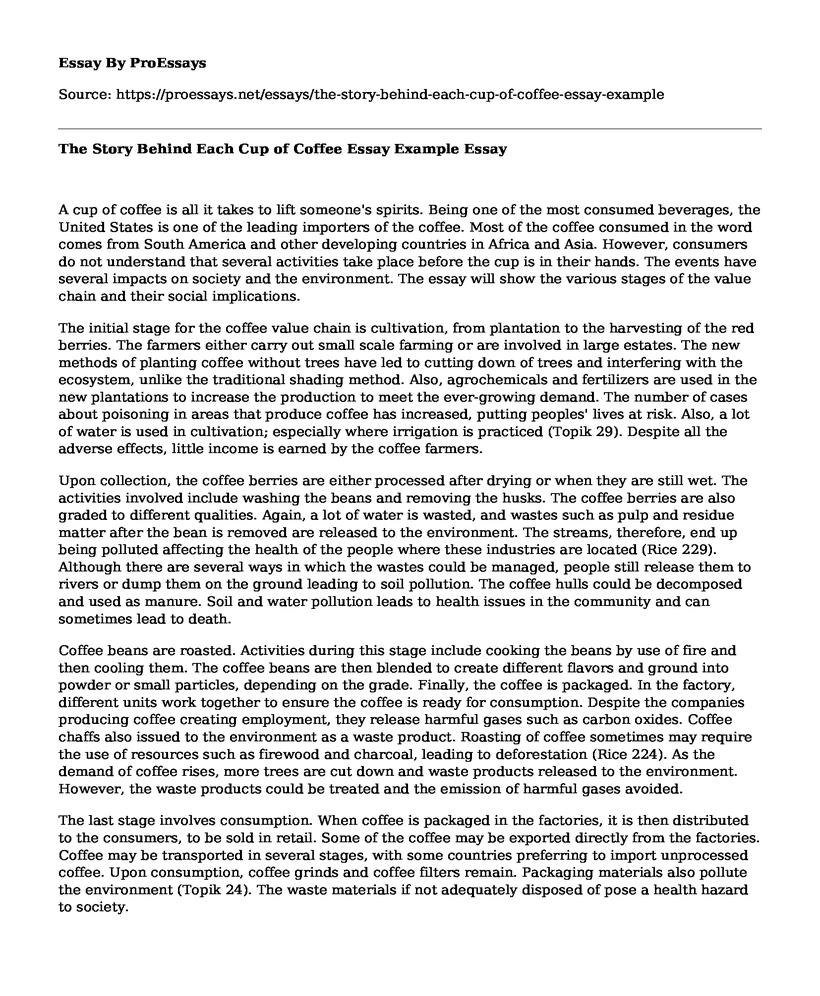A cup of coffee is all it takes to lift someone's spirits. Being one of the most consumed beverages, the United States is one of the leading importers of the coffee. Most of the coffee consumed in the word comes from South America and other developing countries in Africa and Asia. However, consumers do not understand that several activities take place before the cup is in their hands. The events have several impacts on society and the environment. The essay will show the various stages of the value chain and their social implications.
The initial stage for the coffee value chain is cultivation, from plantation to the harvesting of the red berries. The farmers either carry out small scale farming or are involved in large estates. The new methods of planting coffee without trees have led to cutting down of trees and interfering with the ecosystem, unlike the traditional shading method. Also, agrochemicals and fertilizers are used in the new plantations to increase the production to meet the ever-growing demand. The number of cases about poisoning in areas that produce coffee has increased, putting peoples' lives at risk. Also, a lot of water is used in cultivation; especially where irrigation is practiced (Topik 29). Despite all the adverse effects, little income is earned by the coffee farmers.
Upon collection, the coffee berries are either processed after drying or when they are still wet. The activities involved include washing the beans and removing the husks. The coffee berries are also graded to different qualities. Again, a lot of water is wasted, and wastes such as pulp and residue matter after the bean is removed are released to the environment. The streams, therefore, end up being polluted affecting the health of the people where these industries are located (Rice 229). Although there are several ways in which the wastes could be managed, people still release them to rivers or dump them on the ground leading to soil pollution. The coffee hulls could be decomposed and used as manure. Soil and water pollution leads to health issues in the community and can sometimes lead to death.
Coffee beans are roasted. Activities during this stage include cooking the beans by use of fire and then cooling them. The coffee beans are then blended to create different flavors and ground into powder or small particles, depending on the grade. Finally, the coffee is packaged. In the factory, different units work together to ensure the coffee is ready for consumption. Despite the companies producing coffee creating employment, they release harmful gases such as carbon oxides. Coffee chaffs also issued to the environment as a waste product. Roasting of coffee sometimes may require the use of resources such as firewood and charcoal, leading to deforestation (Rice 224). As the demand of coffee rises, more trees are cut down and waste products released to the environment. However, the waste products could be treated and the emission of harmful gases avoided.
The last stage involves consumption. When coffee is packaged in the factories, it is then distributed to the consumers, to be sold in retail. Some of the coffee may be exported directly from the factories. Coffee may be transported in several stages, with some countries preferring to import unprocessed coffee. Upon consumption, coffee grinds and coffee filters remain. Packaging materials also pollute the environment (Topik 24). The waste materials if not adequately disposed of pose a health hazard to society.
Conclusion
Although a cup of coffee brings people together, the whole process followed until the mug is on the table has several social effects on the people. The increasing market price may not affect the lives of the farmers since most of the coffee is imported while still unprocessed. Farmers should, therefore, adopt methods of farming that are friendly to the environment while industries can be regulated to control waste disposal. Furthermore, farmers should have more control over the issue of prices to ensure their efforts do not go unrewarded. Each company should ensure ethical practices are followed before delivering a cup of coffee. From the time a plant was planted, to when it is ready, each cup of coffee has a story to tell!
Works Cited
Rice, Robert. "Coffee production in a time of crisis: social and environmental connections." SAIS review 23.1 (2003): 221-245.
Topik, Steven. "Trade History: From the Tree to the Futures Market, the Historical Process of Coffee Commodification, 1500-Today." Beyond Free Trade. Palgrave Macmillan, London, 2015. 17-35, link.springer.com/chapter/10.1057/9781137412737_2
Cite this page
The Story Behind Each Cup of Coffee Essay Example. (2022, Dec 10). Retrieved from https://proessays.net/essays/the-story-behind-each-cup-of-coffee-essay-example
If you are the original author of this essay and no longer wish to have it published on the ProEssays website, please click below to request its removal:
- Some Questions on Strategic Management
- Organizational Behavior and Public Management Paper Example
- Essay Sample on Leadership Philosophy
- Cultural Competent for Health Care Providers Paper Example
- 3 Steps for Successful Change Management in Organizations - Essay Sample
- Research Paper on Organizational Strategic Planning: Change for Thriving & Outperforming Competitors
- Sound Leadership: Crucial for Healthcare Quality Outcomes - Essay Sample







